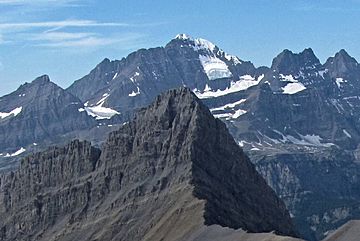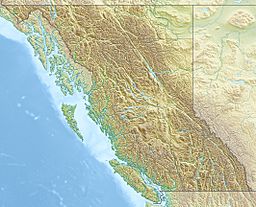Mount King George (British Columbia) facts for kids
Quick facts for kids Mount King George |
|
|---|---|

Mount King George, highest peak in the distance
|
|
| Highest point | |
| Elevation | 3,413 m (11,198 ft) |
| Prominence | 1,329 m (4,360 ft) |
| Parent peak | Mount Joffre (3433 m) |
| Listing | Canada highest major peaks 44th |
| Geography | |
| Location | Height of the Rockies Prov. Park British Columbia, Canada |
| Parent range | The Royal Group Canadian Rockies |
| Topo map | NTS 82J11 |
| Geology | |
| Age of rock | Cambrian |
| Type of rock | sedimentary rock |
| Climbing | |
| First ascent | 1919 by Val Fynn, Rudolph Aemmer |
| Easiest route | Mountaineering |
Mount King George is a very tall mountain in British Columbia, Canada. It stands 3,413-metre (11,198-foot) high! You can find it in Height of the Rockies Provincial Park, which is part of the amazing Canadian Rockies.
Mount King George is the highest point in a special group of mountains called The Royal Group. This group also includes mountains named after other royal family members, like Mount Queen Mary and Mount Prince Albert. The closest taller mountain is Mount Joffre, about 16.0 km (9.9 mi) to the east.
The rocks that make up Mount King George are called sedimentary rocks. These rocks formed a very long time ago, during the Cambrian period, in shallow seas. Over millions of years, these rocks were pushed up and over younger rocks. This happened during a huge mountain-building event called the Laramide orogeny.
History of Mount King George
Mount King George got its name in 1917. It was named by a group called the Interprovincial Boundary Survey. They named it after King George V, who was the King of the United Kingdom from 1910 to 1936. The name became official on February 23, 1918.
The first ascent means the first time anyone successfully climbed to the very top of the mountain. This happened on August 10, 1919. The climbers were Val Fynn and his guide, Rudolph Aemmer.
Because Mount King George is so far away and hard to reach, it took a long time for anyone else to climb it. The second ascent didn't happen until 1970! That's 51 years later. Gerry Brown, William Hurst, and John Carter were the brave climbers who made the second trip to the top.
Climbing Mount King George
Mountaineers have found different ways to climb Mount King George. Here are some of the paths they have used:
- East Face-North Ridge: This was the very first route used in 1919.
- Southeast Ridge: This was the path taken for the second climb in 1970.
- Southwest Face-West Ridge: Climbed in 1971 by D. Hurrell and R. Mills.
- Congdon-McNab Couloir: First climbed in 1980 by Dwayne Congdon and Dave McNab.
- East Face: First climbed in 1984 by F. Campbell, R. Varnam, and K. Nagy.
- Elzinga-Welsted: First climbed in 2012 by Jim Elzinga and Ian Welsted.
Climate and Nature
Mount King George is in a subarctic climate zone. This means it has very cold winters with lots of snow. The summers are usually mild, not too hot.
Because of this cold climate, there's a glacier on the eastern side of the mountain. It's called the King George Glacier. In winter, temperatures can drop below −20 °C. With the wind blowing, it can feel even colder, sometimes below −30 °C!
The water from melting snow and ice on the mountain flows into streams. These streams then join the Palliser River. If you want to climb Mount King George, the best time to go is from July to September. Late summer is also the best time to cross the Palliser River, as the water levels are usually lower.



